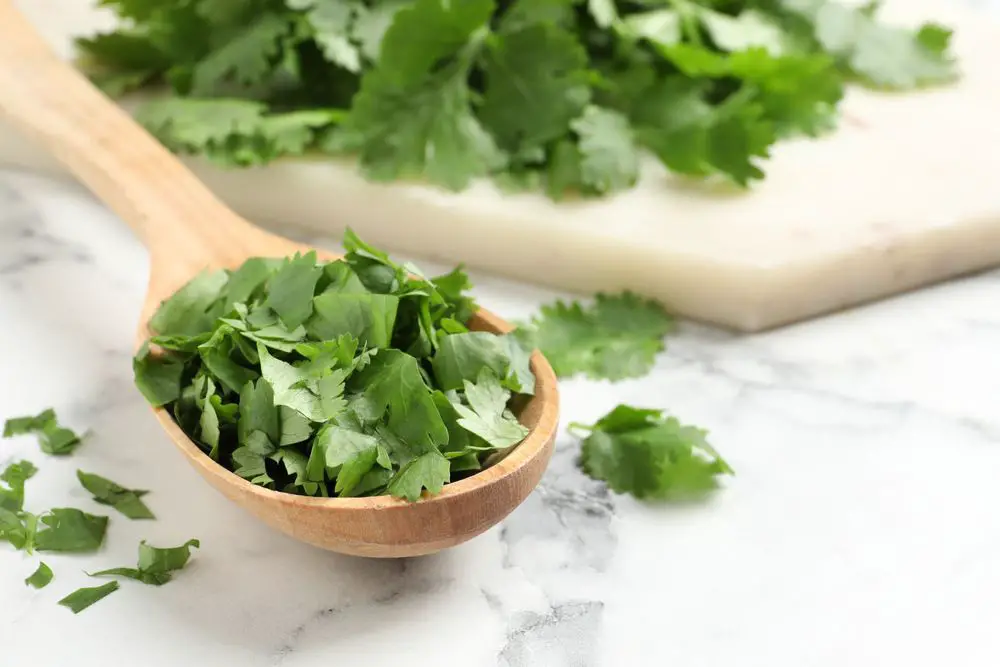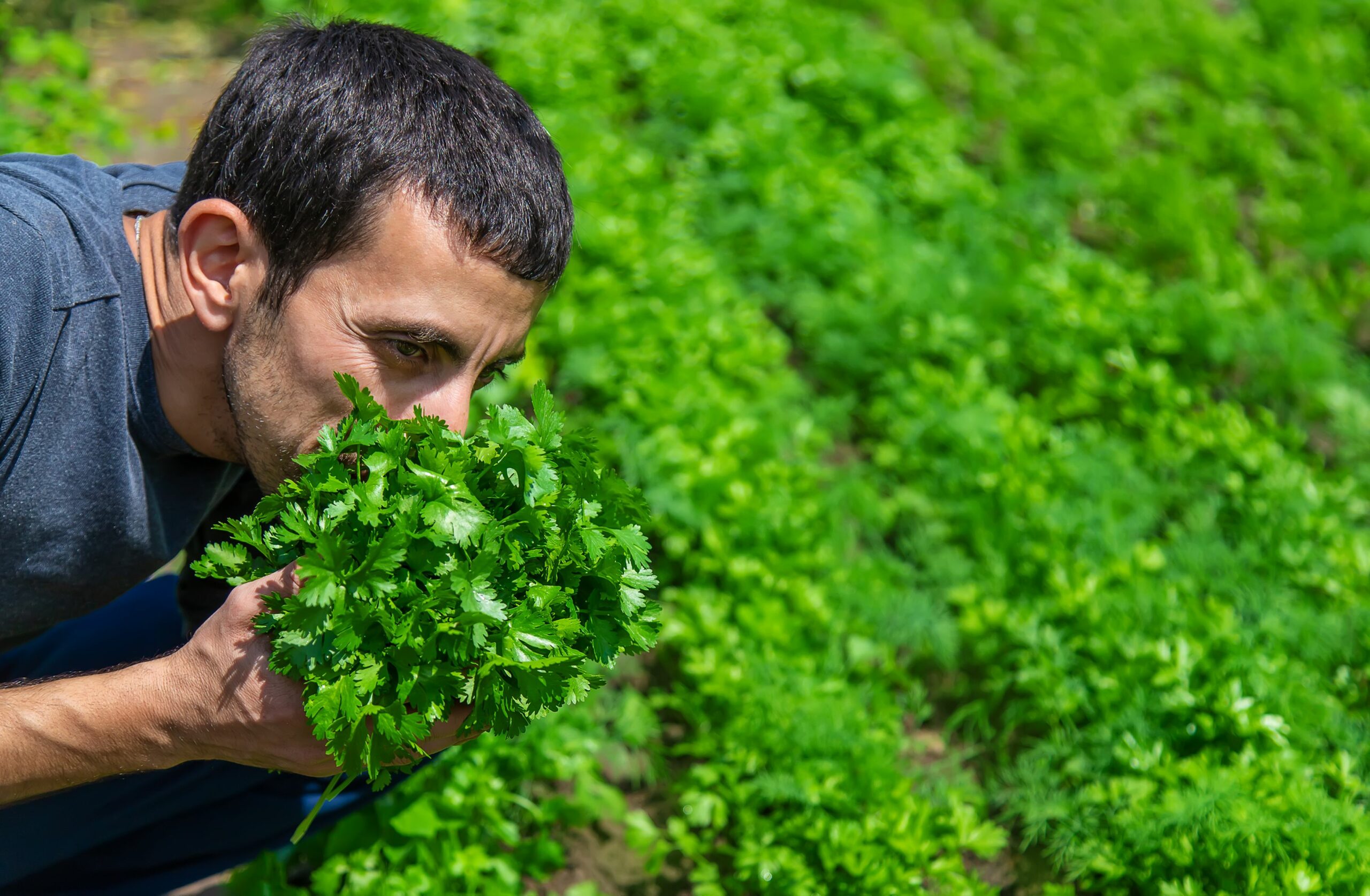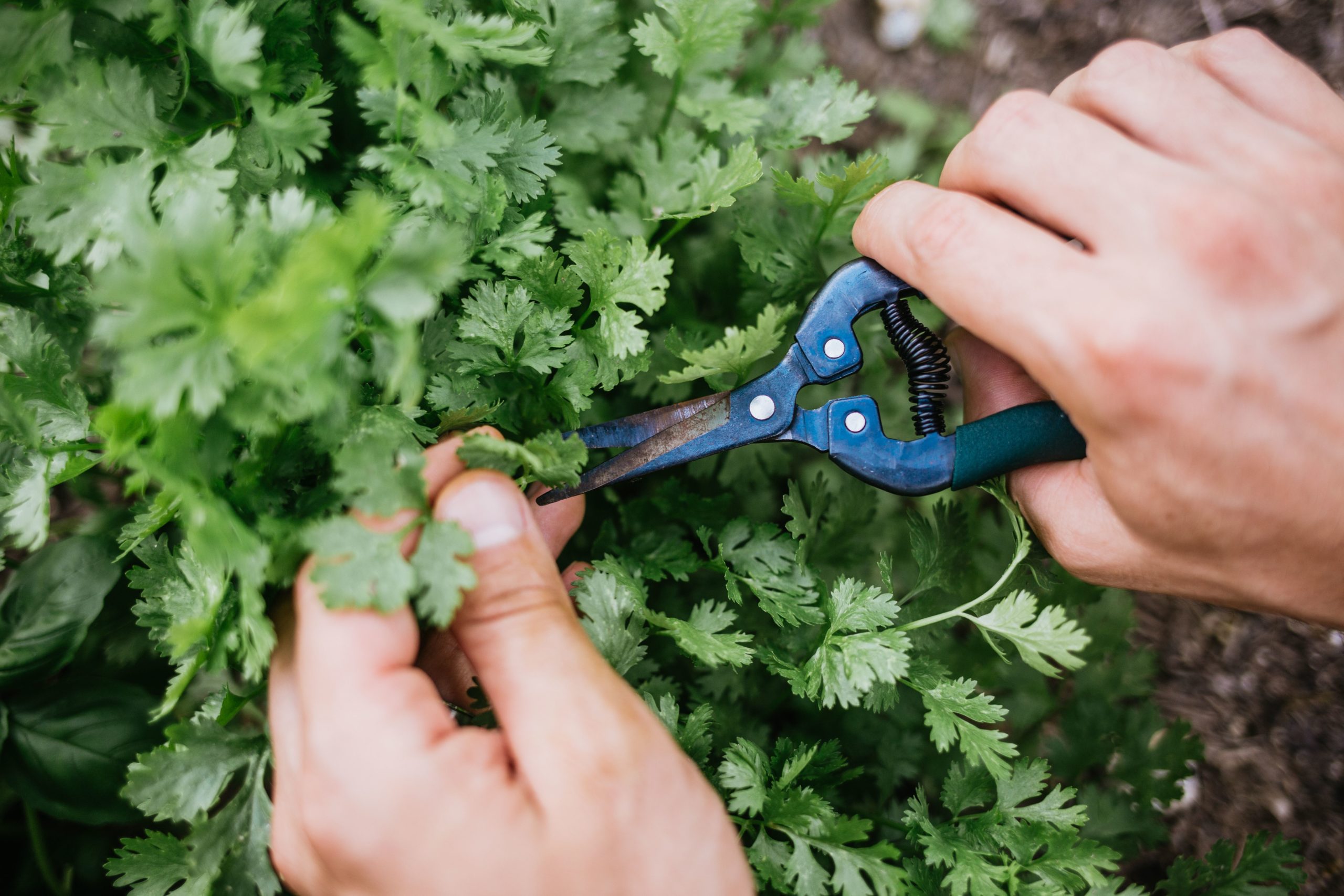Harvesting Cilantro without killing it.
Who doesn’t love cilantro? Also, and more widely known, as coriander! It is also called Chinese Parsley. Or, to give it its botanical name, Coriander Sativa.
In North America and Spain, the leaves and stalks of this plant are called cilantro, and the seeds are called coriander. However, in all other parts of the world, the leaves, stalks and seeds are known as coriander. In this article, we refer to the plant as cilantro.
The best time to harvest Cilantro is when it’s around 4 to 6 weeks old, or about 6 inches tall. Using a sharp knife or scissors, start from the outside and select only the leafiest stem. Cut it from the bottom without damaging other stems. Next, take other lush well-developed stems in the same manner, working from the outside towards the centre but never cutting in the centre and leaving over one-third of the plant.
This flavorful herb and spice have a delicate yet pungent and complex flavor.
Interestingly, cilantro comes in two forms in the kitchen, either as seeds or as a herb.
When using the seeds (they’re globally known as coriander) for cooking, they must be dry roasted first and pounded to unleash their wonderful essence.
We commonly see cilantro leaves in the kitchen, and cooking experts primarily use them in a salad, garnish for a savory dish, or blend in with several sauces.
They’re very popular in cooking shows, where Chefs seem to put their hands on a pot full of growing herb plants and cut off just the right amount of the correct herb for the dish they’re cooking.
Did these chefs grow their herbs in pots – who knows?
Cilantro is extremely popular in the kitchen – due to its unique flavour. Yet, strangely, it isn’t popular in terms of growing, caring for, or harvesting this plant!

In this article, we’ll explain to you in detail how to successfully grow this most popular of herbs and spices and, if you follow these steps carefully, you’ll be harvesting your crop of container cilantro in no time!
How To Harvest Cilantro Without Killing it
The best time to harvest this herb is when it’s around 4 to 6 weeks old or when it’s about 6 inches tall.
Unlike other plants, harvesting cilantro is a delicate process, so you have to be very careful and calm once you start.
Here are the steps to follow when harvesting cilantro without killing the plant:
Firstly, there are two methods of harvesting cilantro;
It could be done in small or large batches.
Small batch harvesting is when you only take a small portion of the plant for a specific dish and leave the rest in the pot until you need it again.
Large batch harvesting is when you take all the cilantro and store it in your refrigerator, sell it, or use it in cooking large batches.
Either way, if you don’t follow all the necessary procedures designated for each type of harvesting, you risk killing the plant. So, let’s discuss first how to harvest cilantro in large batches whilst keeping the plant alive.
How To Harvest Cilantro in Large Batches
1. Timing Is Everything
When you plan to harvest your cilantro in large batches, it’s best to do it during the cold season, when they actively grow.
It isn’t advisable to gather them in the summer season because that’s when they develop flowers and seeds. Unless you need the seeds, only harvest during the cold season to maximize their lush leaves, which have a wider cooking application than the seeds.
2. Examine The Plant
Examine that the plant is ready by measuring the height to get the mature leaves and stems you need.
It’s crucial because cilantro stems should be mature before cutting the leaves. If the stems are not developed, they won’t have enough strength to recover from the severe harvesting
3. Do Not Harvest The Plant Entirely.
Our ultimate goal here is to harvest cilantro without killing the plant, and the best way to do that when you harvest in large batches, you must leave untouched more than one-third of the plant.
The remaining plant will encourage new growth for the next batch in the harvest season. This is a great way to make use of the plant for the longest time.
4. Use A Sharp Knife Or Scissors Only!
Again, harvesting cilantro, especially in large batches, requires a delicate touch. Hence, you must use a sharp knife or scissors only for precise cuts without damaging other stems and encouraging further growth.
Prioritize cutting the largest leafy stems and start cutting them from the base of the plant.
You must be very careful because you are using a sharp object, which can easily cut other stems that aren’t a part of the harvest.
Remember, you need to leave one-third of the plant; hence carefully cut one stem at a time.
How To Harvest Cilantro In Small Batches?
1. Take Only What Is Needed
Since you will use it on a specific dish, only take what is necessary, i.e. the appropriate amount to put in the recipe. Less is more. Taking too much is wasting. Just benefit from the plant and don’t make any waste.
2. Pick The Outer Leaves Of The Plant
The outer leaves of the plant are the most desirable parts because of their original taste.
Older cilantro leaves are bitter and not ideal for cooking. Using the outer leaves of the plant will not kill it. Instead, it will probably encourage new growth.
3. Use A Sharp Knife Or Scissors Only!
Don’t forget to use a sharp knife or scissors when harvesting cilantro. The same goes for large and small batches. They have to be cut with a sharp knife or scissors.
You will often see cooking experts on television skillfully pluck cilantro leaves straight from the pot.
You can also do this by locating the plant’s outer leaves and pinch from the node because this is where new growth will occur.
Eventually, you will get used to it and pluck like those personalities you see on television.
4. Remove older stems and leaves
After plucking the most mature and desirable stems and leaves for cooking, you should also remove older stems and leaves above them to give space for new growth.
This method is most efficient to maximize the plant because older stems and leaves have a bitter taste, so it is best to remove them and let another growth occur.
When doing this, always handle the plant delicately to avoid causing any damage when removing the stem. This way, we can keep the plant alive.
How To Store Cilantro Leaves?
For whatever reason, if you prefer harvesting enough cilantro for a week or so and store it in your refrigerator, maybe that’s the most convenient way for you.
Here are the methods to follow to keep your cilantro leaves as good as newly harvested:
1. Keep It Fresh
To do this, you need a jar filled with water up to about 3 inches. Cut the bottom part of the cilantro before putting it inside the jar for water absorption. Next, place a plastic cover over it and put it in your refrigerator; now, you have fresh cilantro leaves ready to use anytime.
2. Freezing Cilantro Leaves
Freezing cilantro leaves is also an excellent way to preserve their freshness. Chop off the cilantro leaves according to your preference but see to it that they can fit into the size of your mold.
Use ice cube trays or bigger containers with water and freeze them alongside your cilantro.
3. Drying Cilantro Leaves
The drying method is something we shouldn’t forget when it comes to spices. After washing the cilantro leaves, cut only the leaves of the cilantro leaving behind the stem. Bake the cilantro for 20-30 minutes and keep the dried cilantro leaves in an airtight container to last for a year.
How To Successfully Grow and Maintain A Healthy Cilantro?

Before we reach the harvesting period, we have to grow healthy cilantro first. To do that, here are the things to remember:
4. Observe Proper Weather Conditions
As mentioned earlier, cilantro actively grows in the cold season, so it is best to plant your cilantro seeds during this period. The ideal temperature for cilantro is around 10 to 29 degrees Celsius. Anything beyond this number is unsafe for the plant.
Always remember to plant your cilantro during the cold season. Planting it during the summer season will make the cilantro leaves taste bitter.
5. Observe Sun Exposure
As much as it’s not ideal for planting during the summer season, cilantro is also wary of exposure to too much heat.
This plant is susceptible when it comes to heat. If it’s overly exposed, it starts developing flowers and seeds. So unless you don’t need the flowers and seeds, please keep your cilantro plant in a cooler environment.
Plants need nutrients from the sun, however, so the cilantro needs to be exposed to the sunlight for at least 2 to 4 hours in the morning where the heat conditions are not extreme.
During summer, when temperatures are extremely high, do not expose the cilantro to direct sunlight. Instead, please put your cilantro plants in an area with partial shade to balance the extreme temperatures from the sun.
6. Cilantro’s Soil Requirements
There are not many soil requirements when growing cilantro. The plant likes a well-drained and loamy soil with a pH level of 6.5 to 7.0. In these conditions, the plant will grow healthy.
In terms of fertilizers, add the fertilizers appropriate for seed germination if needed. Otherwise, you only have to add fertilizers or compost in the soil after three weeks when the seeds have fully germinated.
If you plant your cilantro in a small garden in your backyard, you may consider putting mulch around the plant to discourage weed growth. Applying mulch may not be needed if you grow your cilantro in a spot away from the weeds.
7. Watering Cycle
Cilantro plants prefer to be watered every week to keep the soil loamy and moist. Unfortunately, you have to do this for the first three weeks after planting the seeds.
When irrigating the plant, make sure that the water reaches the roots but do not make it to a point where it is soaked.
It’s always best to do any watering in the morning. That way, the plants don’t sit with cold, wet roots at night.
If you plant your cilantro in a pot or customized container, ensure that it has a proper drainage system to avoid water logging leading to root rot.
8. Proper Spacing Of Planting Cilantro
If you plant your cilantro in a small backyard, you must allocate at least 6 to 8 inches of distance from each other with a space of rows 12 to 15 inches apart.
This spacing is sufficient to give the cilantro plants adequate room to fully grow without getting clogged as they can grow up to 18 to 24 inches tall.
If you plant them in individual pots or containers, be sure that the size of the container is capable of holding enough soil together with the cilantro plant when fully grown.
Final Thoughts on How To Harvest Cilantro Without Killing It (Easy Steps)
There you have it! A comprehensive article about the plant cilantro (also popularly known as coriander), and how to harvest without destroying it.
I do hope you take an interest and grow some for yourselves. It will be handy in your kitchen when you’re cooking those meals that need this herb or spice, and it should make you feel very proud of yourselves for accomplishing such a delicate task!
Just follow our simple and clear instructions, and you’re ‘good to grow” (pardon the pun)! Enjoy!
Read More:
Papalo – A Better Herb than Cilantro? A Full Guide 

